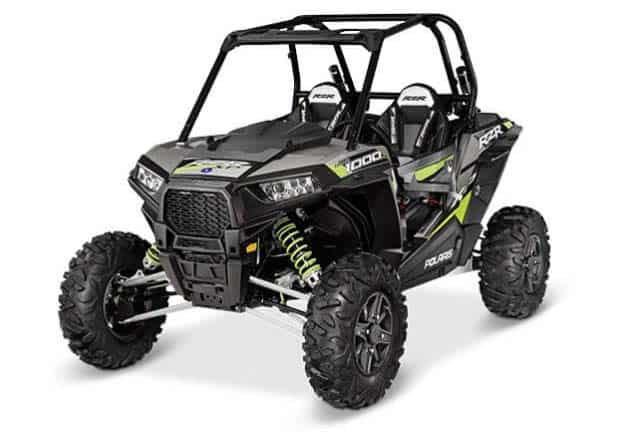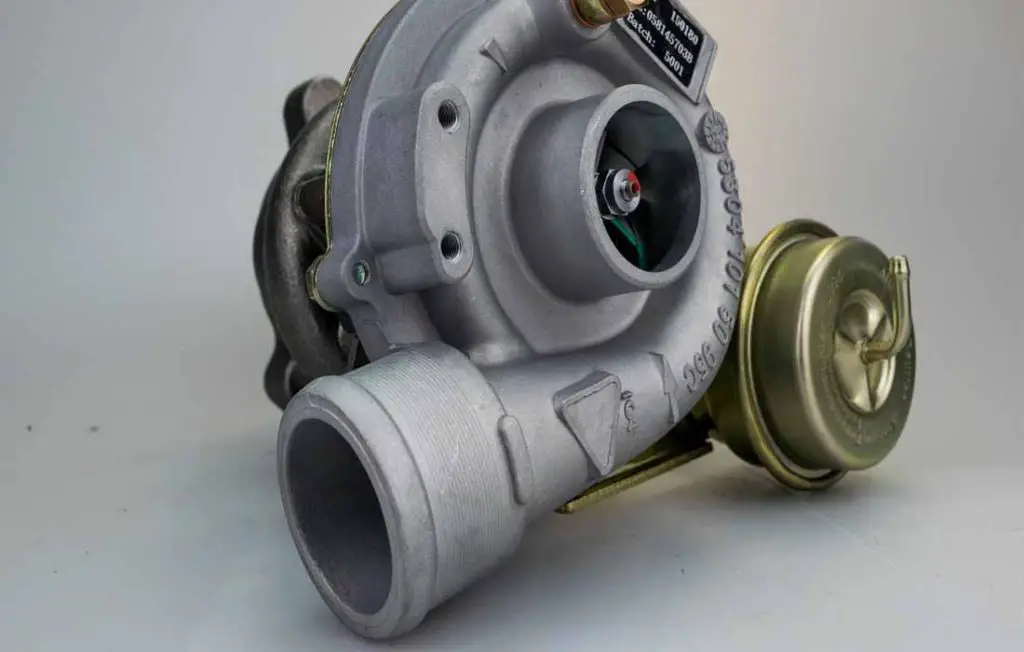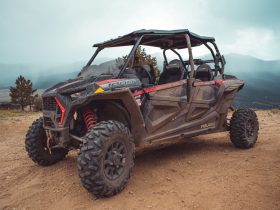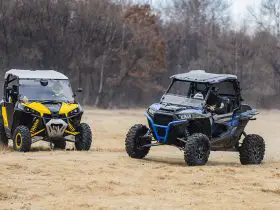Turbo is worth it if you like the extra horsepower and speed it provides. A turbo on UTV engines makes it more efficient and gives you more horsepower and more speed. Turbochargers suits small engines well. But it comes with a higher price tag and make the already expensive Side-by-Sides more expensive.
With turbocharged vehicles starting to increasingly occupy the market, UTV enthusiasts are facing many questions. Is going with a turbo version of side-by-side really worth it? Does more horsepower justify the significant price difference? In fact, does horsepower necessarily matter that much to every UTVer? On the other hand, are the increased power and speed only benefits of turbocharged engines?
Since UTVs demand quite an investment, you want to make sure to you will not regret the decision later on. We’ll dig deeper into numerous factors that need to be taken into consideration, For now, let’s start with the basics.
Table of Contents
How Turbocharging Works?
Turbocharging, in its essence, is an induction method that enables extra amounts of compressed air to enter the engine’s intake manifold at increased pressure. The process is made possible by the turbocharger, an added component comprised of a turbine and an air compressor.,
This pressurized air bursts into the combustion chamber at the time the piston makes a downward stroke. After combustion, exhaust air goes through the turbocharger, spinning the turbines and compressor wheel. The use of exhaust air is basically what differs turbo from naturally aspirated engines. Spinning the compressor wheel draws cool atmospheric air from the opposite side and process restarts.
Simply put, the more air passes through the cylinders, the more power they produce. Turbocharging allows smaller engines to produce a higher amount of power. Of course, this comes in handy when constructing smaller vehicles in need of more punch and speed, such as UTVs.
Find out more at https://en.wikipedia.org/wiki/Turbocharger

The First UTVs with Factory-Installed Turbocharged Engines
Turbocharged side-by-side is a relatively new development in the industry. The first UTV that had a turbo engine straight from the factory was Can-Am X ds 1000R turbo in 2014. Its appearance caused a big splash on the market and enticed other manufacturers to answer with their own turbocharged vehicles. Polaris soon followed, premiering their RZR XP Turbo EPS in July 2015. The introduction of these UTVs triggered a horsepower war. with all the major players in the industry, especially in the US, continuing to evolve the platform. Notably, the whole process is still in the early stages, and manufacturers still sometimes struggle with occasional bugs and flaws.
The development of turbocharged side-by-sides was mainly motivated by regulations set by certain states and racing organizations. Most of them adhere to ROHVA’s (Recreation Off-Highway Vehicle Association) definition of UTVs which states that they have to have engines up yo 1000cc. Turbos created a way to give racers more power and speed within these displacement restrictions.

The Advantages of Turbocharged UTVs
Power
The main draw of side-by-sides with turbo engines is power. Turbocharging enables vehicles with smaller engines to produce more power without needing to upgrade or buy a new machine. Almost all types of UTV riders can benefit from having more muscle. No matter if you’re climbing up the dunes, desert racing, or aggressively riding the trails having more power will make for a more thrilling and enjoyable experience.
Speed
With more power also comes more speed. Since turbo helps produce more power in the smaller engines, it enables keeping the overall weight of the vehicle down. That is why these rides run faster than the speed of the average UTV. This is at the top of the reasons why many pro racers are embracing turbocharged machines.
Better Overall Specs and More Options
The important advantage of turbocharged UTVs is that they tend to have better overall specs and more extra options than non-turbo vehicles. this includes better steering rack, improved clutch, higher-quality seats, more solid axles, more durable belts, and stronger front differential. This is not something you’ll find on stock models without turbo engines.
The Disadvantages of Turbocharged UTVs
Cost
Let’s be honest. The main thing that puts people away from turbocharged machines is the price tag. Buying UTV with turbocharger already fitted can significantly set you back financially. Compared to non-turbo counterparts the cost of owning side-by-side turbo equipped vehicles is rather high. Of course, when you look at the factors contributing to the price, it’s understandable. Turbo, cooling ducting, extra intake, intercooler, and, as we mentioned, the better specs push the cost way up.
Consider the Polaris RZR XP Turbo. It’s manufacturers suggested retail price is $21.000. Its non-turbo cousin RZR XP 100o can be yours for $18.600. You need to ask yourself if for you, personally, the difference is worth 24 hundred bucks.
Maintenance and Reliability
And this is all without the cost of maintenance or some extra gear you might want to add. With turbo engines, there are more parts and more things that can go wrong. Turbocharging raises the pressure and temperature in the engine which can cause some parts, such as valves and pistons, to wear out more quickly. And replacement parts can be quite expensive.
Remember, turbo technology in the UTV world is still new, and manufacturers themselves are still often in trial and error mode. Although they do everything to make vehicles more reliable, there’s still plenty of room for improvement.

Things to Consider When Choosing Between Turbo and Non-Turbo
Fuel Mileage
This part is a bit tricky. Turbocharged UTVs can be more or less fuel-efficient than naturally aspired vehicles depending on which angle you look at it from. Typically, turbo engines are smaller which leads to increased fuel economy. However, a lot of UTVers enjoy riding hard and aggressive. Especially with the amount of speed and power offered by turbo engines at their disposal. Under heavy throttle, the turbo will force more air into the engine causing it to burn more fuel. This way, fuel efficiency can quickly drop off.
Preferred Riding Style
People enjoy riding side-by-sides for various reasons. And UTV’s offer opportunities to implement a plethora of different riding styles. Desert racing or dune climbing enthusiasts will certainly enjoy the power and punch that turbo brings. But, for others, who get their kick from slowly exploring trails having all that power is not essential. The same goes for technical rock riders. They will rarely find themselves needing more power than they can have with non-turbo machines.
Geography
Part of the world where you do your riding can impact your decision on pulling the trigger and buying turbocharged UTV. This means both the area where you plan to use your vehicle and the structure of terrain on which you’ll be riding.
For, example, if you live and ride in parts of the country with a high altitude of over 5.000ft, going with turbo might be a good idea. High altitudes lead to the loss of intake manifold pressure. Supposedly, you lose about 3% of horsepower for every 1000ft above sea level. The force induction performed by turbocharger can make up for the loss of the pressure. This is the reason why aircraft are mostly manufactured with turbocharged engines. Also, if you ride in warmer parts of the world, consider the fact that sometimes turbochargers don’t always perform to their best in hot weather.
As for the terrain topography considerations, they are pretty self-explanatory. Riding fast and aggressive in the area with a lot of trees or poor visibility might not be the best idea safety-wise for you, your vehicle, or anyone you might tun into on the road.
Considering the Priorities
So, we already know that going turbo can cost significantly more than buying a vehicle with an NA engine. It’s up to you to carefully consider if the money difference can be put to better use. Particularly if you’re operating on a tight budget. Not buying a turbo side-by-side can enable you to make upgrades elsewhere. If you feel that speed and power are not essential to your riding style, there is plenty of other stuff you can invest in, mostly regarding safety. The money saved buying non-turbo UTV can be spent on the harness, cage, or paddles. You may also choose to boost the NA engine on the vehicle.

After Market Turbo Kit Options
Another option to consider if you want turbocharged UTV is adding a turbo to your NA engine. Beware, unless you are an expert yourself, this can end costing more than buying a turbo straight from the factory. After market turbo kits can be a bit pricey and good UTV technicians don’t come cheap either. The process is complicated and goes beyond simply applying fans to the engine. It’ possible, that to make space for the new parts, you may need to alter some of the bodywork. Also, newly gained power and speed can put a serious strain on the whole vehicle. This means that you’ll probably have to enforce braking and suspension systems. The wise thing to do is check with your local UTV workshop and ask for advice regarding the procedure and price.
The List of the UTV Models with Turbo
Here are some popular UTVs with turbocharged engines. When looking at UTVs you can find out pretty fast from the model name or the manufacturers website if the model has a turbocharger. The manufacturers will let you know you.
Polaris
- RZR XP4 Turbo S
- RZR XP4 Turbo S Dynamix
- RZR XP4 Turbo S Velocity
- RZR XP Turbo S
- RZR XP Turbo Dynamix
- RZR XP Turbo Velocity
- RZR XP4 Turbo LE
- RZR XP4 Turbo
- RZR XP Turbo LE
- RZR XP Turbo
Can-Am
- Maverick x3 Turbo
- Maverick X3 Turbo DS
- Maverick X3 X RS Turbo RR
- Maverick X3 MAx Turbo
Good luck with your UTV rides. And drive safe! Read our 10 Tips on UTV Safety.










